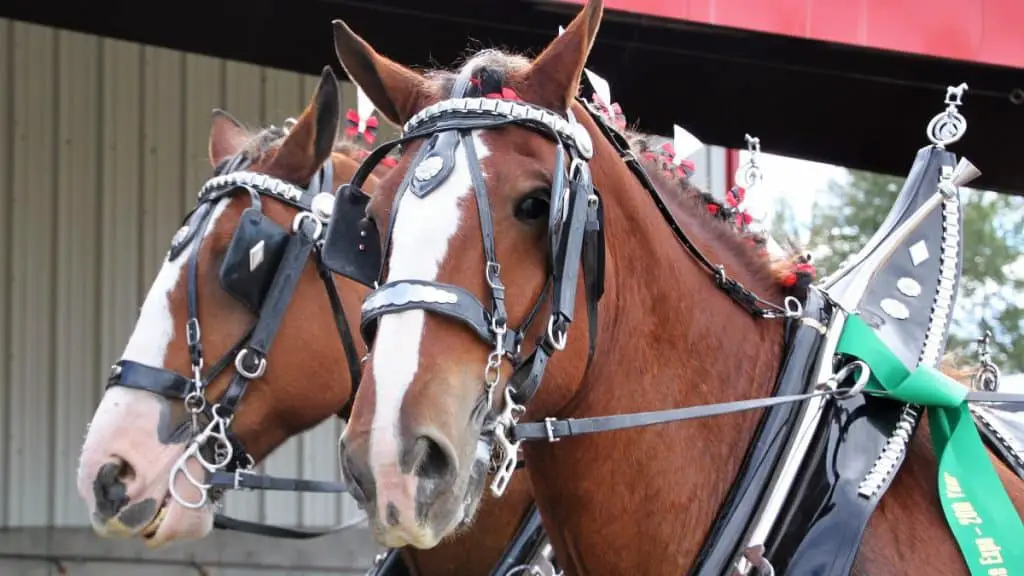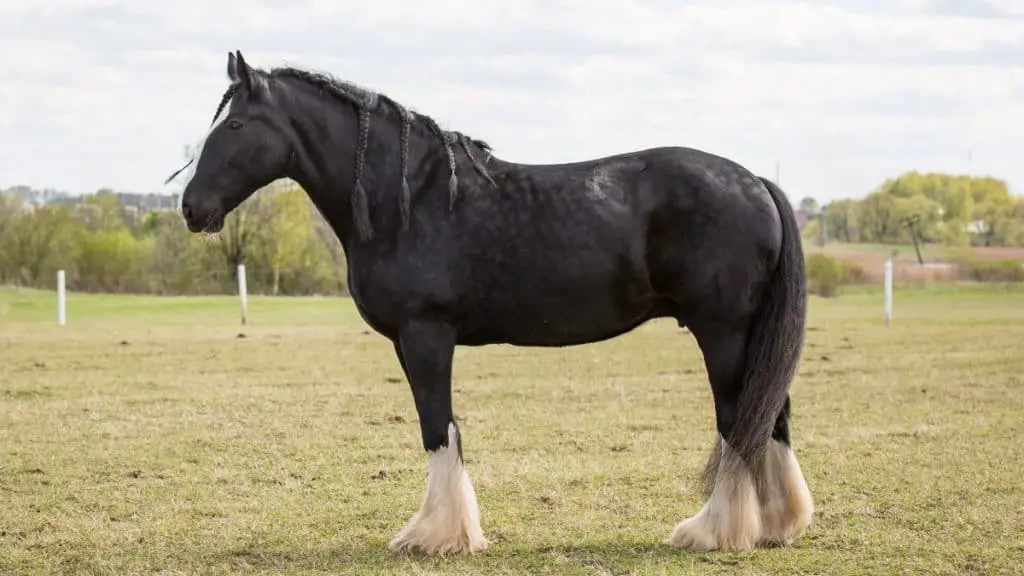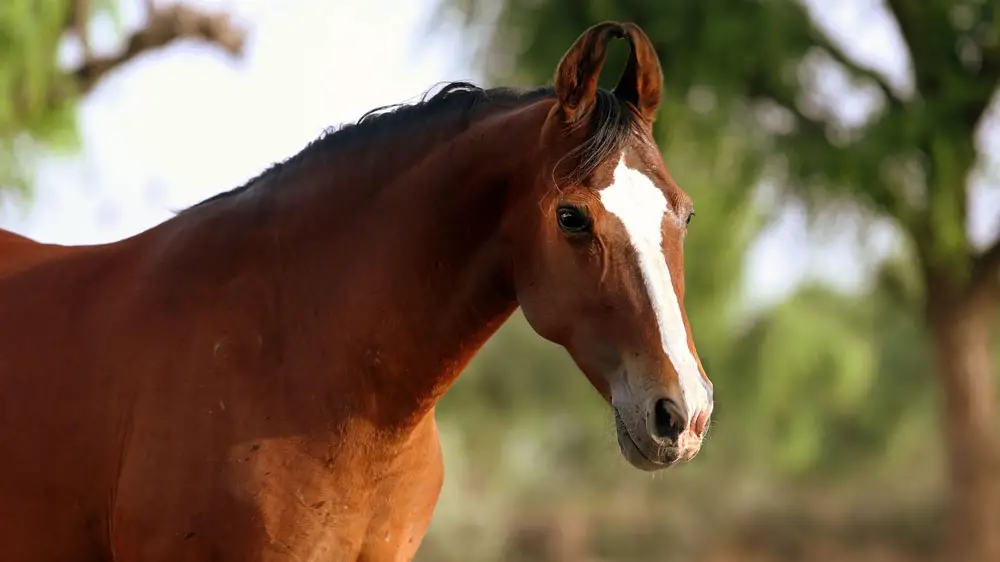Skip To Section
If you are a big fan of horses, you may be wondering what rare horse breeds there are. Which horses are there only a few of in the world? What do they look like, and is there any reason they’re rare?
We’ve looked at the rarest and most unusual horses that exist today.
Let’s discover them!
1. The Canadian Horse

According to Black Heart Equestrian, the Canadian horse is among the rarest horse breeds left in the world, with only around 6000 being left. They were almost wiped out in the US Civil War, and despite being a popular breed, have struggled to repopulate.
They are excellent for jumping and speed, leading to their use in races, and they are strong and resilient.
The breed is thought to be 350 years old, and to have originated when Louis XIV sent a ship full of horses to his subjects in New France. These horses bred with each other, and the Canadian horse was the result.
2. The Clydesdale Horse

This spectacular horse, which stands around 16.2hh, is a very powerful work horse. It has a short back and strong muscles and was bred to manage heavy farm work and the work of industry.
In terms of looks, the Clydesdale horse has finely feathered lower legs, and a stocky, powerful body. It usually has white on its face, with black, bay, or brown in the body. It has a high step, making it one of the more desirable work horses for show.
It was the result of pairings between Flemish stallions and mares from the Clyde valley and has existed since the eighteenth century. It was very popular for work, but its popularity and numbers have declined since we moved toward mechanical power for farming and industry.
3. The Hackney

Next, the Hackney horse is another rare breed, which came from Norfolk in England originally, and can grow up to 16.2hh. They are very elegant horses which, according to Britannica, were once considered high style for pulling carriages.
They are now popular as show horses, with a flashy trot and high step. They are well-muscled and usually dark in color, but most are nervous and need good trainers who can handle them and know their cues.
It is thought that only around 3000 of these horses now exist, and most of these are in England.
4. The Shire Horse

Another horse of English origin, many people will be familiar with Shire horses, which have a very distinctive look and are famous for their great size. It originated from the great English War Horse in the medieval period.
These magnificent horses were used for agricultural work, haulage, and combat. They can stand up to 17.2hh, and they have very low numbers, of less than 2000 across the globe. It is thought that they have survived because of their beauty, but whether that will continue remains to be seen.
They are usually dark colors, with white, feathered feet, and often have a white stripe on their muzzles. They have also been used to breed other horses, such as the Lincolnshire Black.
Today, they are mostly used in promotional work for brands, partly because of their highly impressive looks and graceful proportions.
5. The Akhal-Teke

Thought to be one of the oldest existing breeds, according to Horsey Hooves, the Akhal-Teke is extremely striking. It has a slender, delicate look to it, but is coveted for endurance and speed. It is particularly well known for its extraordinary stamina.
It comes from the deserts of Turkmenistan, and its amazingly glossy coat and stunning coloration have made it popular across the world, although it used to be most popular in Asia. With numbers of less than 3500, it is certainly a rare horse, in spite of its usefulness and beauty.
It is thought to be among the oldest and purest breeds in the world, and was originally used as a war horse in Asia, and then in Russia.
It stands between 14 and 16hh, and has a very beautiful coat with a unique hair structure that looks almost metallic, especially in sunlight. These horses can be dun with black points, cremello, bay, black, palomino, gray, or chestnut, so there is a broad range of colors.
They tend to bond closely with their owners and do not readily take to other riders or handlers.
6. The Marwari

From the Marwar region of India, the Marwari is another exceptionally beautiful horse that is known for its endurance. It is generally used for riding and light agricultural work.
It has particularly distinctive inward-turned ears that give it a very recognizable head. Horse Breeds Pictures shows these beautifully clearly.
They can stand up to 16hh, and nowadays are often used in ceremonies, for transport, in shows, and for religious purposes. They are very hardy creatures and can come in a whole range of colors, such as piebald, palomino, roan, skewbald, bay, etc.
They are one of the rarest horses; about 900 are thought to live in India, but there are only about 30 outside of it, making it extremely unusual.
7. The Bashkir Curly
There do not seem to be accurate numbers for this extraordinary horse with a curly coat, but it is thought that the registry started with just 21 horses. They are popular horses, being calm, reliable, friendly, intelligent, and easily trainable.
They are also thought to be the only hypoallergenic horse, but they can shed their coats entirely in summer, which some owners find unappealing. Horse Breed Pictures states that they can grow to 16hh, and there is much confusion over their origin and breeding history.
8. The Cleveland Bay

Critically endangered, the Cleveland Bay is a stunning horse, with an elegant body and short, strong legs. It is patronized by the English royal family, and it is only due to this that the breed has survived at all; it fell out of use in the early 20th century and was almost wiped out.
In 1977, Queen Elizabeth II became a patron of the Cleveland Bay Society, and this brought the breed back from the brink of extinction. The horses are used to pull royal carriages at times, and they were also one of the earliest breeds to be used in show jumping.
However, despite efforts from all sides, the horses remain rare, and only around 900 are thought to exist globally.
9. The American Cream Horse
Another horse that suffered immensely from the mechanization of agriculture, this breed had the misfortune to only be developed as farming habits began to change and mechanical equipment took the place of horses. It was bred around the start of the 20th century, and due to the changes in habits, never really took off.
It is the only American draft horse that is still alive, according to Black Heart Equestrian, and has a stunning cream coat, amber eyes, and a strong, muscled body. It carries the champagne dilution gene, and stands at around 16.3hh, with a quiet, gentle nature.
It seems that every draft horse breed suffered from the mechanization of farming. White horses are unusual, and the American Cream deserves protection.
10. The Dales Pony
Dales ponies are usually between 14 and 14.2hh, and they can be black, gray, bay, roan, or brown. These ponies are known for excellent endurance, and a good ability to work well even on rough, challenging terrain.
Their numbers suffered massively during the Second World War, when the army took many, for use in the battles and for breeding vanners. They are popular, but listed as “critical” on the Rare Breeds Survival Trust, according to Horse And Hound.
11. The Galiceño
Possibly the rarest horse breed in the world, with less than 100 true purebreds left, the Galiceño only measures 13.2hh at the most. It is thought to have come from Portuguese horses, from the Iberian Peninsula.
These stunning horses are good for light work, but will also serve as pack animals, riding animals, and for running and jumping. They come in all common colors, and have particularly graceful proportions, with smooth contours.
Horse Breeds Pictures explains that when Spanish explorers landed in America in the sixteenth century, they brought the Andalusian horse and the Galician ponies. The Galician ponies bred with the European Garrano horses of Portugal.
This led to the birth of the Galiceño, which is highly prized for being fast, comfortable to ride, and having excellent stamina.
The future of this breed looks particularly uncertain, as it is thought that few of the existing Galiceño horses are in breeding condition, meaning that the breed could disappear within a short space of time unless intervention is made to save it.
12. The Black Forest Horse
According to Horse Racing Sense, the Black Forest horse may only have around 1200 specimens left globally. This beautiful creature is one of the horse breeds originating from southwestern Germany.
It stands up to 15.3hh and is famous for endurance, hardiness, and being easy to keep. They have powerful hindquarters, good hoofs, and agile movement.
These horses have to be sorrel or chestnut, and must have a flaxen tail; any other colors are not considered part of the same breed. This is also called fox coloration in Germany.
13. The Suffolk Punch

Another of the very large work horses, the Suffolk Punch can stand up to 17.2hh, and is heavily muscled. Rarest says that it is considered among the oldest draft horses, and it originates from England.
It was used for plowing heavy clay soils, but its popularity – like that of many working horses – declined when machinery took over after World War II.
These horses have a distinctive look, always being some variation of chestnut, and only ever having a white star marking (if any marking at all). There are now very few Suffolk Punches worldwide, with about 600 in the United States, and only around 200 in England.
The horse is known for having a good temperament, being very docile. It also lives a long time, and has excellent stamina, which is why it was so suited as a work horse.
14. The Caspain Horse

Among the smaller horses, the Caspian horse stands at only 11.2hh, according to HorseAndHound. However, it is a horse and not a pony, due to the structure of its bones.
It is thought to date back to 3000 B.C. and was thought to be extinct for some years, until a group of wild horses was discovered living in Iran. These were used to repopulate the species, though it is still very rare.
The discovery was made by a man called Louise Firouz, an American who was living in Iran. These horses are thought to be the most direct ancestor of the Oriental horse breeds.
They are good for young riders, and can be crossed with taller breeds to make them exceptional horses for older riders too. They are known for having an excellent gait and being superb jumpers.
It is thought that original Caspian horses may have stood only around 9hh, according to OKStateEdu. It also points out that because the Caspian horses used to revive the breed were scattered, none can really be considered “purebred” horses, though they do have very distinctive characteristics.
The breed remains rare, although breeding stock now exist in the UK, Australia, New Zealand, and the USA, as well as in their original home of Iran.
15. The Exmoor Pony
Finally, the Exmoor pony stands up to 12.3hh, and is usually brown, dun, or bay. It has existed on Exmoor since ancient history, and there are still semi-feral ponies up there.
They have not been influenced much by outside breeds, and according to Horse And Hound, they are the oldest horse breed in the UK. There are only thought to be about 500 of the ponies on Exmoor, but there are around 3500 around the rest of the UK and the world.
Despite relatively healthy numbers, the breeding situation does not look good as many are not in a position to breed.
These ponies are considered wild because they roam freely, but they do all have owners. Many people visiting Exmoor look forward to seeing these ponies, and in spring and early summer, their foals.
Conclusion
There are many rare horses in the world, and sadly a lot have been made rare by changes in our habits and requirements. Lots of societies exist to promote and protect the different species, trying to ensure their continued existence in spite of sometimes difficult odds.
